Why Users Mute Push Notifications
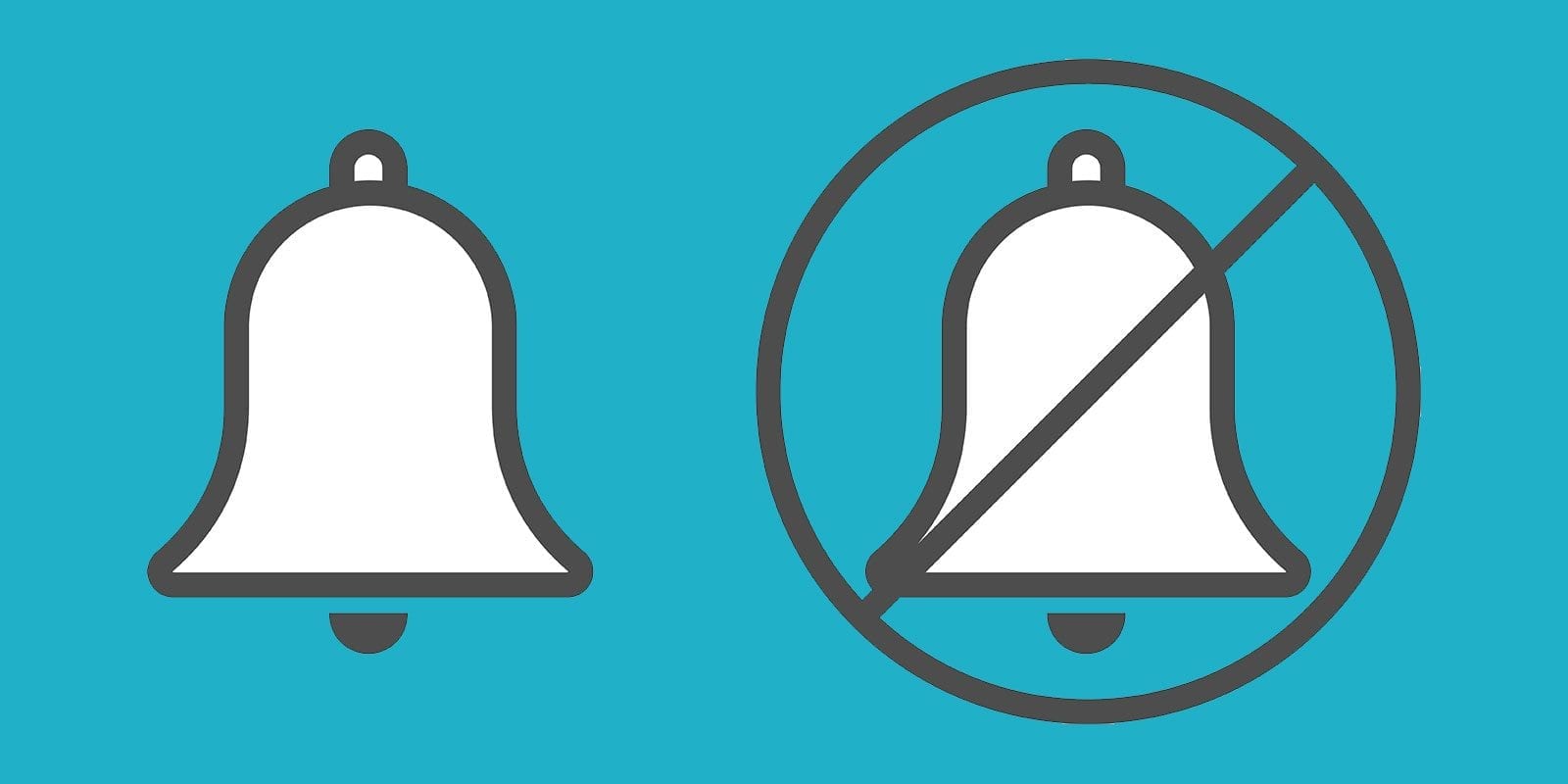
Do you want to communicate with the people who downloaded your app even when they’re not using it?
Push notifications can accomplish this.
You can send notifications directly to each user’s device, and it will appear on their screen as if they just received a text message.
Sounds like a great way to engage with your audience, right?
There’s not a clear black and white answer here. Push notifications can be helpful, but only when they’re used properly.
If you’re improperly taking advantage of this tool, then it’s going to have the opposite effect. Instead, users will mute your notifications.
That’s a place that you don’t want to find yourself in.
So whether you have an app that’s already been launched or you’re still developing a mobile app, you need to be thinking about push notifications.
On average, more than half of app users enable push notifications.
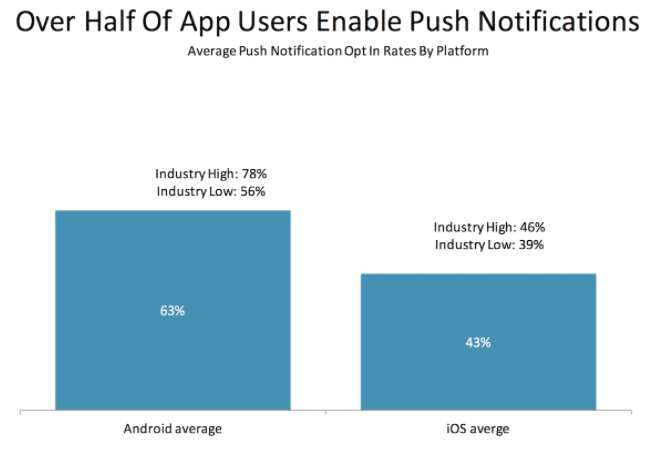

More Android users enable push notifications than iOS users, but Android dominates the global market share. So it’s safe to say that the majority of people want to get push notifications.
But with that said, there are certain reasons that force a user to turn these notifications off.
If you’ve been getting muted or you’re trying to avoid getting muted, this is the perfect guide for you. I’ll explain why app users mute push notifications and how you can send notifications without getting turned off.
Because they are annoying
52% of app users say that push notifications are an annoying distraction.
However, 26% of users said that they were grateful for push notifications because they get alerts about their interests.
Another 20% of app users stated that notifications enhance productivity. They are able to receive important and timely information without having to launch the app because of push notifications.
So it’s clear that the opinions are split about this subject. However, the fact that over 50% of users find them annoying is just too large of a number to ignore.
The question now changes to, “why are they so annoying?”
I blame marketers for this problem. To sum it up, marketers overuse push notifications. They think that just because someone has downloaded an app that they have a new best friend.
Marketers believe that the users will be so excited about any communication from the app.
But this is obviously not the case.
Let me rewind for a minute here. I don’t want you to get the wrong idea. I’m definitely not trying to give marketing experts a bad name. Without your marketing department, your app wouldn’t be successful.
However, you’ve got to understand how marketers think. It’s all about numbers for them.
They are looking at the total number of people who downloaded your app. If half of them mute your notifications, the marketers don’t care. Your marketing team assumes that they can make up for those losses just by sheer volume and by targeting the people who still have them turned on.
In theory, it’s not a bad idea. But that’s not how you want to treat your app users.
You want as many people as possible to be engaged and satisfied with your app. So alienating half of your audience is the wrong approach.
Annoying your user base can cause even more damage than you think. Sending too many push notifications can cause your users to stop using your app altogether.
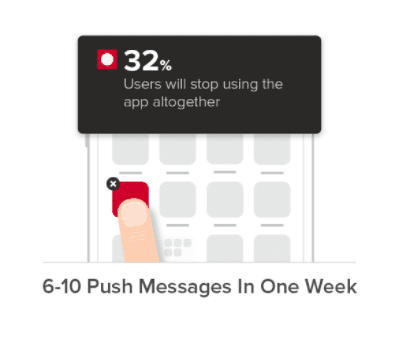

This a problem that’s going to be much harder to recover from.
Here’s an argument that I’ve heard from marketing teams that I’ve consulted with on this matter.
“It’s not a big deal if the notifications get muted because the people will still continue using the app. We can make money every time they use it.”
Well, according to the data above, that argument can be thrown right out of the window. App abandonment is a serious problem. If those rates get too high, it could be the downfall of your company.
You can decrease the chances of abandonment if you pump the breaks on your push notification strategy. Re-evaluate how often you’re sending out these notifications and figure out what users want to hear from you.
This brings us to our next point.
The ones that aren’t annoying are:
Not all push notifications are annoying.
As we discussed earlier, research shows that just under half of users found them to be helpful. They get alerts and timely information without having to open the app. This enhances their experience with your company.
Something else that you need to consider about push notifications is what type of app you have. Depending on your industry, you’ll have a greater chance of having higher opt-in rates.
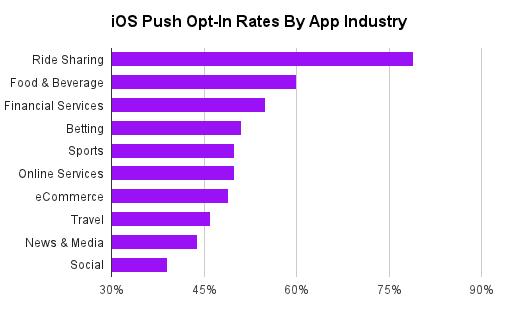

As you can see from the data, people just don’t want push notifications from certain industries.
Look at the bottom three on this list.
It makes sense that people don’t want to be notified about travel deals on a daily or weekly basis if they’re only taking one or two vacations all year.
There are already enough outlets available for people to get their news. They don’t want to get a notification every time something happens.
As for social media, users get enough of that throughout their day. Not everyone wants their phone to buzz every time a picture gets liked.
But with that said, if your app doesn’t fall within the top industries for push notification opt-ins, you can still reduce the chances of getting muted.
Here’s what all notifications that aren’t perceived as annoying have in common:
Personalized
Notifications have to be relevant to each user. You can’t just send a blanket mass-message to everyone who has your app. That’s ineffective.
To show you what I’m talking about, I’m going to use really obvious examples to help paint a picture.
Let’s say you have an ecommerce store and your mobile app is another platform for customers to shop. You wouldn’t want to send notifications about dresses and skirts going on sale to male users.
It’s not personal, it’s irrelevant, and it’s annoying. That’s a fast way to get people to mute your notifications.
But if you send something more personal, like a discount that’s related to something the user has purchased in the past, it will definitely increase their engagement.
You’ll also see an increase in your conversion rates as well.
Here’s another example. Let’s say your app is hosting or sponsoring an event. Maybe your app is in the sports industry, and you’re sponsoring a surf contest in southern California.
Sending a push notification could be a great way to increase attendance at the event, right?
Not if you’re sending the notification to people who live in Minnesota, Maine, or New Jersey.
Instead, it would make much more sense if you were to send that push notification to people who live within reasonable driving distance to the event.
Still not convinced that your notifications have to be personalized? Well, studies show that personalized offers is the number one type of push notification that app users want to receive.
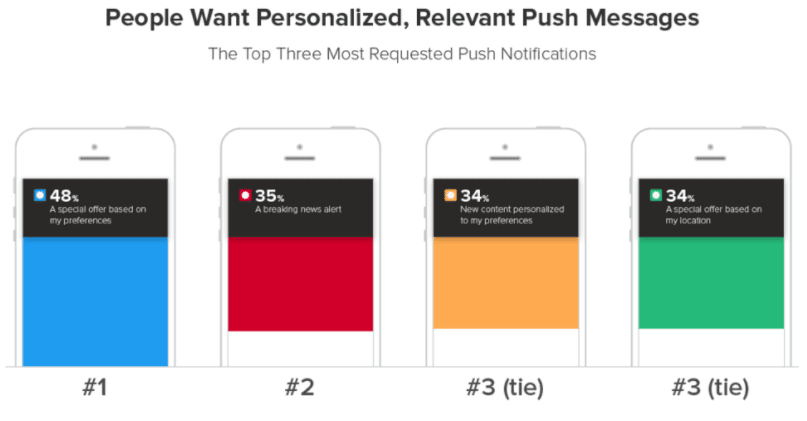

On top of the 48% of people who want personalized offers, an additional 34% of users want to receive new content based on their personal preferences as well.
So over 80% of respondents cited some form of personalization as the type of notification that they want to receive the most.
You just can’t argue with numbers like that.
Not sent very often
Just because you’re sending a personalized offer to your app users, it doesn’t mean that you should send out notifications every day.
Be selective.
Put lots of thought into each notification that you send and make sure that you do this very sparingly.
Remember, the reason why people mute notifications is because they’re annoying. As we saw earlier, sending too many notifications in a week can be so annoying that it will cause people to stop using your app altogether.
So how often should you send notifications?
I’d say once a week, at most. But probably even less. You can limit this to two or three times per month if you really want to eliminate the chances of getting muted.
Take a look at this data. It shows how many weekly push notifications from one app cause users to disable notifications for that app.
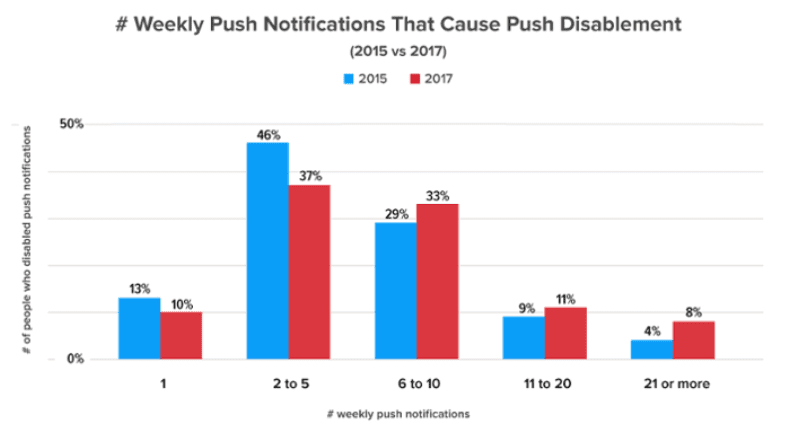

As you can see, even sending two or more push notifications in a week can cause 37% of people to mute notifications for your app.
Sending one per week has a much lower opt-out rate at just 10%. But with that said, people are still muting notifications if you send one per week. That’s why I recommended sending a little bit less than that.
But like we discussed earlier, these numbers will vary slightly depending on your industry.
Have immediate value
People won’t mute push notifications if they add immediate value. Certain apps send notifications that are timely and absolutely necessary based on the needs and functionality of the app.
For example, let’s use a popular app like Uber as an example.
You request a ride using the Uber app. While you still have the app open, it will show you how long until your car arrives. Let’s say that your ride will be at your pick up location in 15 minutes.
Nobody wants to check their phone or wristwatch every few minutes to see when they need to be ready. People also don’t want to just stare mindlessly at the app while tracking the GPS location of their driver.
Users also don’t want to have to stand outside for 15 minutes waiting for their driver to arrive.
That’s when push notifications come in handy. Getting notified that your Uber has arrived is definitely something that people want to see.


That’s because it makes the user’s life easier and adds immediate value. They know that after their ride has been requested, they don’t have to do anything except wait for their notification that the car has arrived.
Remember the graph we saw earlier about the top industries for push notification opt-ins? Ride sharing was at the top of that list with a 79% opt-in rate. So it’s obvious that this model is successful.
The food and beverage industry was second on the list with a 60% opt-in rate.
Again, that’s because those notifications add immediate value. Getting a notification that your pizza has arrived makes things easier for the app user and enhances their experience.
So think of ways you can apply this concept to your app the next time you want to send a notification. If it’s not adding immediate value, you should probably think twice before you hit send.
Give a discount on a flash sale
What do consumers love more than anything?
Getting discounts and free stuff. So if you’re sending push notifications about a flash sale or some kind of deal, users won’t think that it’s annoying.
Just make sure that you’re not doing it too often.
This is a great strategy to boost sales on your app as well. Obviously, the user downloaded your app because they have some kind of interest in your brand.
Either they’ve bought something from your company in the past or planned to do so in the future.
Sending a push notification with a discount could be the driving force behind getting a conversion.
Here’s a great example of what I’m talking about from Charlotte Russe.


Users won’t be annoyed by this notification because they have the opportunity to buy something at a discounted rate.
They wouldn’t have known about this deal unless they happened to open up the app during that time frame.
So rather than seeing this as an annoyance, users will be grateful that they were sent a push notification that can save them some money.
If you’re selling products or services through your app, I highly recommend that you employ this push notification strategy.
How to get people to turn on notifications again
Some of you may have found this guide when it was too late. People have already muted your push notifications.
Hopefully, you didn’t send them too many to the point where they completely abandoned the app.
So how do you get users who still have the app installed to enable push notifications after muting them? It may not sound possible since you obviously can’t send them a notification, but there’s still hope.
Don’t forget about your other marketing channels. When a user signed up for your app or created a profile, you may have asked for their email address.
Send them an email and explain how the push notifications will improve their life.
Give them a relevant offer. Send them something for free.
You can also promote these offers on other marketing channels as well, such as your Facebook or Instagram page.
Let your followers know that you’ll be periodically sending free gifts or discounts in the form of push notifications.
Once you get people to opt-in to your notifications, make sure you follow the tips we talked about earlier so you won’t annoy them.
Conclusion
Push notifications are a great way to communicate with your app users, but only if they’re used properly and sparingly.
People turn off push notifications because they are already annoyed by too many things in their life. They don’t want another thing to annoy them.
But there are certain types of notifications that people don’t find annoying. Those are push notifications that:
- are personalized
- don’t get sent too often
- add immediate value
- offer free stuff and discounts
Keep this information in mind when you’re coming up with a push notification strategy for your app.
Refer back to the data and research that I outlined throughout this guide.
If you follow these tips, fewer users will mute your notifications, which will increase their engagement.
What types of push notifications are you sending to your app users?